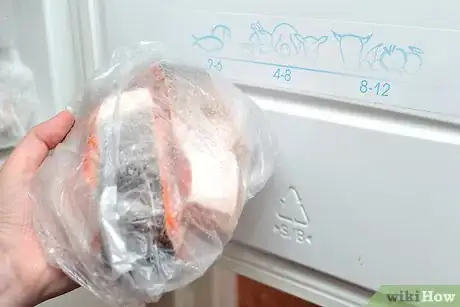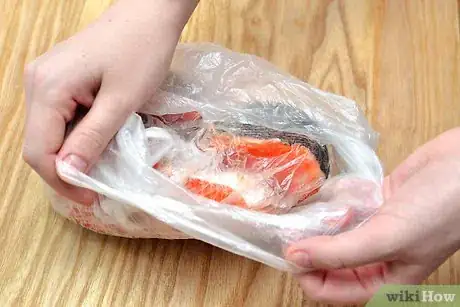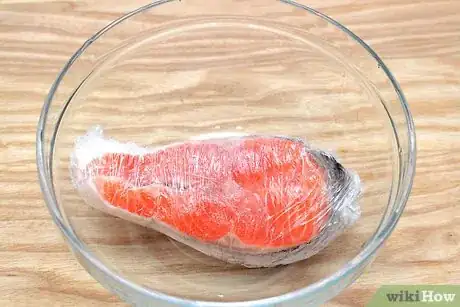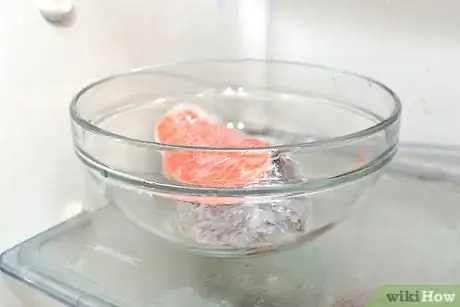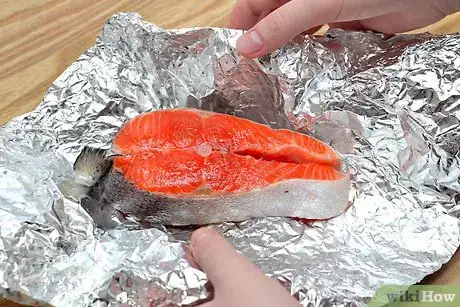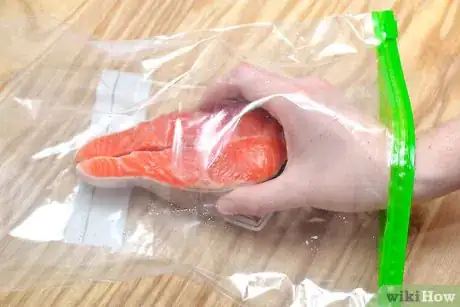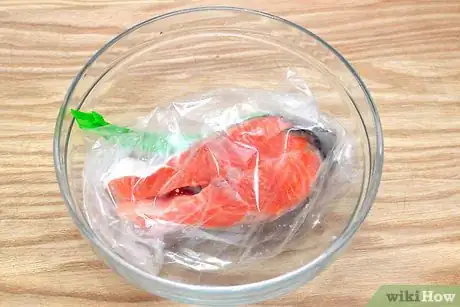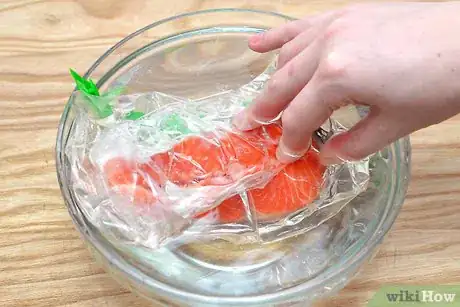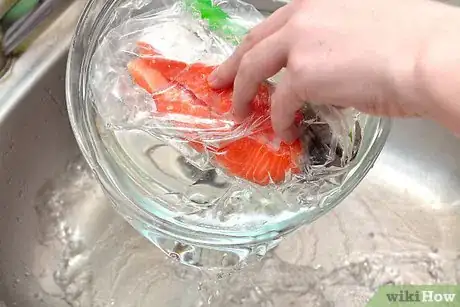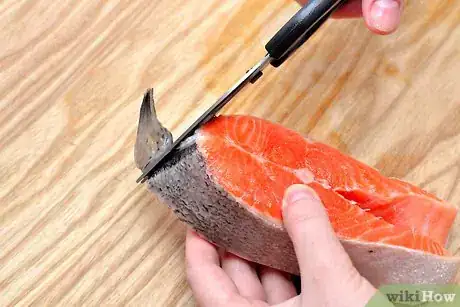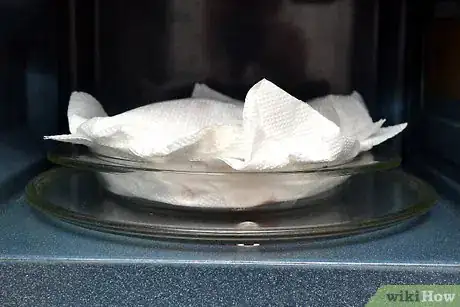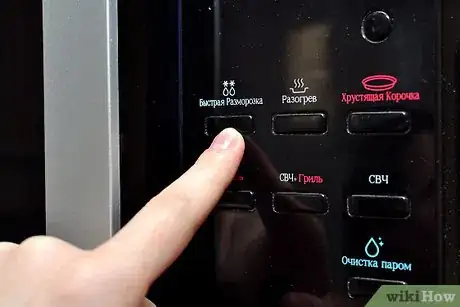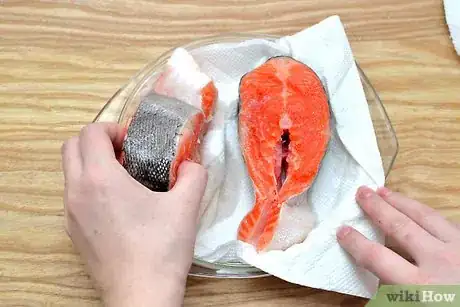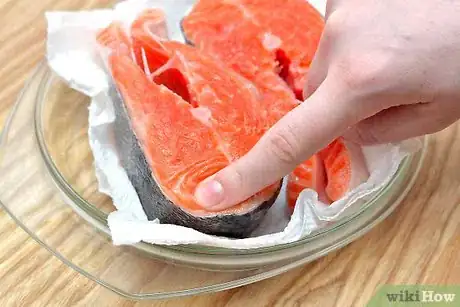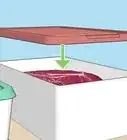This article was co-authored by wikiHow Staff. Our trained team of editors and researchers validate articles for accuracy and comprehensiveness. wikiHow's Content Management Team carefully monitors the work from our editorial staff to ensure that each article is backed by trusted research and meets our high quality standards.
The wikiHow Video Team also followed the article's instructions and verified that they work.
This article has been viewed 975,161 times.
Learn more...
Salmon, a white, orange or red fleshed-fish is native to the North Atlantic Ocean and Pacific Ocean. Fresh salmon is full of excellent nutrients, like protein, omega-3 and vitamin D. Salmon is commonly smoked, grilled, broiled, baked and occasionally eaten raw. The fish is best when cooked fresh after catching or buying it; however, if it is frozen there are some guidelines you should follow to prevent contaminating the seafood and ruining its flavor. This article will tell you how to defrost salmon.
Steps
Refrigerator Defrosting
-
1Remove your salmon from the freezer approximately 12 hours before you plan to cook it. For quantities over 1 lb. (454 g), remove the salmon 24 hours before you plan to cook it.
-
2Unwrap the outer layers if it is wrapped in more than 1 freezer bag or layer of aluminum foil.Advertisement
-
3Place the fish in a shallow bowl.
-
4Put the bowl on a flat surface in the refrigerator, away from foods that will soak up the smell of the salmon. The refrigerator should be kept between 35 and 40 degrees Fahrenheit (1.7 to 4.4 degrees Celsius), in order to inhibit the growth of micro organisms.
-
5Cook immediately after removing the salmon from the refrigerator.
Sink Defrosting
-
1Remove the salmon from the freezer. You will need to allow 30 minutes of defrosting time for every 1 lb. (454 g) of fish before you plan to cook it.
-
2Make sure the fish is in a plastic bag, if it is not already. This will keep the raw fish from spreading bacteria.
-
3Place the salmon in a large bowl. The fish should be able to be fully submerged when the bowl is filled with water.
- You can also use the sink to thaw your fish; however, it should be dedicated to keeping the fish during defrosting to avoid contamination.
-
4Fill the bowl or sink with cold water until the salmon is submerged.
-
5Change the cold water every 30 minutes.
-
6Remove the fish after it is fully thawed and cook immediately.
- If you are thawing salmon that was frozen in a block of ice, run cold water over the fish until all the ice chunks are removed. Then cover the fish in plastic wrap, place it in a pan and leave it in the refrigerator for 6 to 12 hours.
Microwave Defrosting
-
1Remove the salmon from the freezer. Remove packaging.
-
2Place it on a plate covered in paper towels. Cover the fish with a layer of paper towels.
-
3Place the thinnest parts of the fish in the middle of the plate.
-
4Use the defrost setting to heat the fish for 4 to 5 minutes for every 1 lb. (454 g) of fish. The defrost setting is usually 30 percent of the microwave's heating power, or "Power 3" on the controls.
-
5Stop the microwave halfway through the time and turn it over.
-
6Stop the microwave before it has reached the end of its preset defrosting time, so there are some ice crystals remaining.
-
7Place the plate on the counter for 5 minutes to finish defrosting.
-
8Cook immediately.
- Microwave defrosting is the least recommended way to defrost fish. The rapid heating of the flesh causes the fish's cell walls to burst. The fish will likely be unevenly defrosted and dry.
Community Q&A
-
QuestionIs it safe to eat salmon that has been defrosted in the sun for four hours?
 Community AnswerNo, I wouldn't consume any seafood that has been sitting in the sun for four hours, even if it was initially frozen.
Community AnswerNo, I wouldn't consume any seafood that has been sitting in the sun for four hours, even if it was initially frozen. -
QuestionI was defrosting salmon in the sink. It was wrapped in wax paper but not tightly. Water got inside. Is it still safe to eat if baked at 375 degrees?
 Community AnswerYes, the heat will kill any bacteria in the sink. Next time, disinfect your sink before use or put the fish into a large bowl to defrost it.
Community AnswerYes, the heat will kill any bacteria in the sink. Next time, disinfect your sink before use or put the fish into a large bowl to defrost it. -
QuestionHow do I defrost commercially frozen salmon?
 Community AnswerThe safest method is in the refrigerator. You can defrost it for a day. You can also defrost it with a microwave by choosing the defrost option.
Community AnswerThe safest method is in the refrigerator. You can defrost it for a day. You can also defrost it with a microwave by choosing the defrost option.
Warnings
- Make sure it has not been improperly frozen. Home freezers have fluctuating air flow and temperatures and are not meant for long term storage. Eat your salmon within 2 to 3 months after buying and freezing it. If it has been exposed to air, either in the package or in the freezer, it has not been properly frozen and should not be defrosted and eaten.⧼thumbs_response⧽
- Never refreeze salmon after it has thawed.⧼thumbs_response⧽
- Do not thaw fish with warm water. This promotes the growth of bacteria.⧼thumbs_response⧽
Things You'll Need
- Refrigerator
- Sink
- Microwave
- Water
- Paper towels
- Shallow platter
- Salmon
References
About This Article
The safest way to defrost salmon is in the fridge. About 12 hours before you plan to cook your salmon, take it out of the freezer and remove any excess packaging, so it’s wrapped in just one layer of plastic or foil. Set the fish in a shallow bowl and place it on a flat surface in your fridge, preferably away from other foods that could soak up the smell of the salmon as it thaws. After 12 hours, take the salmon out of the fridge and cook it immediately. If you’re in a hurry, skip the fridge and place the frozen salmon in an airtight plastic bag. Then, put the bag in a large bowl or sink basin filled with cold water. This technique usually only takes about half an hour, but if it takes longer, change the water every 30 minutes. Once the salmon is thawed, remove it from the water and cook it right away. For an extra quick defrost, unwrap the salmon and put it on a microwave-safe plate lined with paper towels. Place another layer of paper towels on top of the fish. Set the microwave to “defrost” and microwave the salmon for 4 to 5 minutes for every 1 lb (.45 kg) of fish. Halfway through the defrost time, take the fish out of the microwave and turn it over. When you’re done, let the fish sit on the counter for another 5 minutes to finish defrosting before you cook it. Keep reading to learn how to defrost salmon in the microwave!
